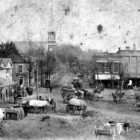Fort Williams to Horseshoe Bend
Fort Williams to Horseshoe Bend
In March 1814, General Andrew Jackson mobilized the Tennessee Militia, made up of Volunteers from the East and West Tennessee Militias and the Thirty-Ninth U.S. Infantry for a full-scale campaign against the Red Sticks.
 General Jackson’s army totaled about 3,000 men. Jackson’s army left Fort Williams on the Coosa River (Mississippi Territory) and marched 52 miles through the forest in three days. Fort Williams, located at the mouth of Cedar Creek and the Coosa River in what is now Talladega County, Alabama was constructed in 1814 to serve as a supply depot preparatory to the Battle of Horseshoe Bend on March 27, 1814.
General Jackson’s army totaled about 3,000 men. Jackson’s army left Fort Williams on the Coosa River (Mississippi Territory) and marched 52 miles through the forest in three days. Fort Williams, located at the mouth of Cedar Creek and the Coosa River in what is now Talladega County, Alabama was constructed in 1814 to serve as a supply depot preparatory to the Battle of Horseshoe Bend on March 27, 1814.
Jackson and his troops made camp six miles north of Horseshoe Bend.
The Red Stick’s had built a barricade on the river, which eventually trapped them once Jackson’s soldiers surrounded them. Over 800 Red Sticks died as a result of the Battle. General Jackson’s dead and wounded were taken back to Ft. Williams.
The Fort Williams Cemetery site was located in Talladega County on a elevated rise on the east side of the Coosa River. The military road to Talladega passed to the north of the cemetery and continued in a northeasterly direction toward its final destination, Talladega . The fort which bore the same name, Fort Williams, lay to the west of the cemetery on a hill. Years earlier, Jackson’s men had transported supplies down the Coosa and hauled them from the water’s edge up the hill which lay in front of the fort. Jackson often transported military supplies down the Coosa River and stored supplies on a hill which overlooked the fort. After frequently placing supplies on the same hill, Jackson ultimately constructed the fort.
Jackson’s army left Fort Williams on the Coosa River (Mississippi Territory) and marched 52 miles through the forest in three days.
/p>
Fort Williams was a supply depot built in early 1814 in preparation for the Battle of Horseshoe Bend. It was located in Alabama on the southeast shore where Cedar Creek met the Coosa River, near Talladega Springs. The original site was submerged under Lay Lake with the 1914 construction of the Lay Dam 14 miles downstream.
Once the Lay dam was constructed on the Coosa River in 1914, water levels began rising near Fort Williams. After years of weathering and erosion, the fort ultimately collapsed and was engulfed by the Coosa River.
Historic Marker Series: Fort Williams
